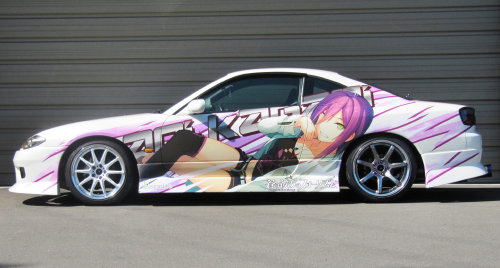Japan has long been known as a global leader in automotive innovation, but beyond performance and engineering, the country has also given birth to one of the most visually striking car customization trends in the world: Itasha. These anime-themed cars, adorned with vibrant illustrations of popular characters from manga, anime, and video games, have evolved into a subculture that blends personal expression, fandom, and artistic creativity. But in recent years, itasha culture has extended beyond just car aesthetics—it has become a fashion statement.

The Origins of Itasha Culture
The term “Itasha” (痛車) literally translates to “painful car,” not because of any physical discomfort but because the flashy, over-the-top designs are often seen as “painfully” embarrassing or excessive to outsiders. This trend emerged in the 1980s, when passionate fans started decorating their vehicles with anime decals. By the 2000s, itasha had gained widespread popularity, with dedicated exhibitions, gatherings, and even sections at major auto shows in Japan.
However, the influence of itasha didn’t stop at the roads—it made its way into streetwear and high fashion, giving rise to a new way of expressing fandom through clothing, accessories, and even luxury brands.

From Cars to Clothing: Itasha’s Fashion Influence
Itasha is not just about decorating cars; it’s about making a statement. Just as fashion allows individuals to express their personality, itasha cars serve as a canvas for self-expression. This philosophy has seamlessly transitioned into streetwear and designer fashion, where the aesthetics of anime, cyberpunk, and J-pop culture have started to shape global fashion trends.
- Anime Streetwear Boom – Brands like “A Bathing Ape” (BAPE), “UNIQLO”, and “Supreme” have collaborated with anime franchises, producing graphic-heavy designs reminiscent of itasha wraps. Hoodies, bomber jackets, and T-shirts featuring anime characters, bright color palettes, and bold typography mirror the aesthetic of an itasha vehicle.
- Cosplay Meets Street Style – Itasha owners often dress to match their car’s theme. Whether it’s wearing a cosplay-inspired jacket or a color-coordinated outfit, the goal is to create a harmonized aesthetic between the person and the car. Events like Comiket and Tokyo Auto Salon showcase fans who blur the lines between cosplay and everyday street fashion.
- Luxury Meets Otaku Culture – High-end brands have started incorporating anime motifs into their collections. “Gucci”, “Louis Vuitton”, and “Balenciaga” have experimented with anime-inspired patterns, catering to a growing market that merges fandom with high fashion. The concept of itasha resonates with this trend by turning everyday items—whether cars or clothing—into wearable or drivable art.

Itasha Events and Their Fashion Scene
Major itasha events, such as Itasha Tengoku (Itasha Heaven) and Akihabara Itasha Meeting, serve as hubs for enthusiasts to showcase their cars and outfits. These gatherings often resemble fashion runways, where attendees coordinate their look to complement their customized vehicles. Common fashion elements at these events include:
- Neon and Cyberpunk Aesthetics – Reflecting the futuristic and digital art style seen in many anime franchises.
- Harajuku Influence – Bold patterns, oversized prints, and colorful accessories that echo the loud, expressive nature of itasha designs.
- Techwear and Street Goth – Dark, edgy styles with tactical elements, resembling characters from futuristic anime.

Global Impact: Itasha Fashion Beyond Japan
What started as a niche subculture in Japan has gained traction worldwide. The influence of itasha can be seen in car meets in the U.S., Europe, and Southeast Asia, where anime-wrapped cars are becoming more mainstream. Similarly, the fusion of anime and fashion has expanded globally, with Western brands embracing the aesthetic.

More Than Just a Car, More Than Just Clothes
Itasha is more than a car culture—it’s a fashion movement that celebrates individuality. Whether in the streets of Tokyo or at anime conventions worldwide, the blend of Japanese car culture and anime-inspired fashion continues to captivate audiences and redefine what it means to wear your passion on your sleeve—or on your car.




